地衣芽孢杆菌WJ53A和同型发酵乳酸菌对玉米青贮梭状芽孢杆菌生长的抑制作用
IF 0.6
4区 农林科学
Q3 AGRICULTURE, MULTIDISCIPLINARY
引用次数: 0
摘要
本研究报道了以副干酪乳杆菌L1a和地衣芽孢杆菌WJ53A为基料的青贮添加剂与3种同质性乳酸菌(嗜酸儿歌球菌12c、副干酪乳杆菌L1a和植物乳杆菌S1aR)的效果对比。为此,对这些分离的乳酸菌进行了拮抗活性测试。测定了分离LAB对青贮酸度、有机酸含量和干物质的影响。采用定量PCR技术估计了保守青贮中真菌和细菌的DNA负荷,并评价了它们对青贮品质的影响。结果表明,L1a + WJ53A组合对青贮玉米均有效,乳酸含量(94.51%,P<0.0001)高于对照(88.28%,P<0.0001)。与对照青贮相比,该联合体的乙酸含量较低(5.49% ~ 10%,P=0.0002),丁酸含量完全没有(0% ~ 1.64%,P<0.0001)。qPCR结果显示,与对照组(0.001127 ng, P=0.0002)相比,联合保存青贮的最终LAB DNA浓度(0.002487 ng, P=0.0002)有所增加,但与接种剂L1a (0.001790 ng, P=0.0219)存在差异。此外,与对照组相比,最终真菌DNA浓度显示了真菌DNA的减少(0.00027 ng对0.00106 ng, P=0.0007)。最有趣的结果是基于qPCR分析的梭状芽胞杆菌生长抑制,该结果表明,与本研究中使用的所有接种剂相比,接种该联盟的青贮饲料中梭状芽胞杆菌的DNA较低(P<0.001)。本研究表明,与同质发酵LAB和地衣芽孢杆菌菌株WJ53A联合青贮的优势,可以降低牲畜养殖中梭状芽孢杆菌感染的风险本文章由计算机程序翻译,如有差异,请以英文原文为准。
Inhibitory effects of Bacillus licheniformis WJ53A and homofermentative lactic acid bacteria on clostridial growth in corn silage
This study reports on the effectiveness of silage additive based on consortium Lacticaseibacillus paracasei L1a and Bacillus licheniformis WJ53A in comparison with three homofermentative lactic acid bacteria (LAB) (Pediococcus acidilactici 12c, L. Lacticaseibacillus paracasei L1a, and L. plantarum S1aR). For this purpose, the antagonistic activity of these isolated LAB was tested. The impact of the isolated LAB on silage acidity, organic acid content, and dry matter of silage was also determined. The fungal and bacterial DNA load in the conserved silages was estimated using quantitative PCR and their effects on the quality category of silage were evaluated. The obtained results showed all inoculants being effective in ensiling of maize with the consortium (L1a + WJ53A), showing a high lactic acid content (94.51%, P<0.0001) in comparison to control (88.28%, P<0.0001). The consortium also showed a lower acetic acid (5.49% to 10%, P=0.0002) and absolutely no butyric acid in respect to control silage (0% to 1.64%, P<0.0001). The qPCR results presented an increase in the final LAB DNA concentration of silage conserved with consortium (0.002487 ng, P=0.0002) when compared to control (0.001127 ng, P=0.0002) but did differ from the inoculant of L1a (0.001790 ng, P=0.0219). Also, the final fungal DNA concentration showed the effectiveness of the consortium by the reduction of fungal DNA in comparison to control (0.00027 ng against 0.00106 ng, P=0.0007). The most interesting result is the inhibition of clostridia growth based on the qPCR analysis which showed a lower clostridial DNA in silage inoculated with the consortium (P<0.001) against all the inoculants used in this study. This research shows the advantage of ensilaging with a consortium of a homofermentative LAB and a Bacillus strain B. licheniformis WJ53A which reduces the risk of clostridial infections in livestock farming
求助全文
通过发布文献求助,成功后即可免费获取论文全文。
去求助
来源期刊

Pakistan Journal of Agricultural Sciences
AGRICULTURE, MULTIDISCIPLINARY-
CiteScore
1.80
自引率
25.00%
发文量
18
审稿时长
6-12 weeks
期刊介绍:
Pakistan Journal of Agricultural Sciences is published in English four times a year. The journal publishes original articles on all aspects of agriculture and allied fields.
 求助内容:
求助内容: 应助结果提醒方式:
应助结果提醒方式:


